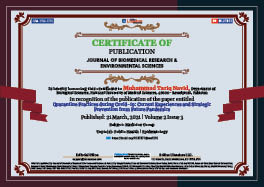> Medicine Group. 2021 Mar 21;2(3):199-200. doi: 10.37871/jbres1210.
Quarantine Practices during Covid-19: Current Experiences and Strategic Prevention from Future Pandemics
Muhammad Tariq Navid1*, Sohail Raza2 and Muhammad Asif Rasheed3
2Institute of Microbiology, University of Veterinary and Animal Sciences, Lahore, 32000, Pakistan
3Department of Biosciences, COMSATS University-Islamabad, Sahiwal Campus, 57000, Sahiwal, Pakistan
- Quarantine practices
- Solation
- COVID-19
- Control strategy
- Public health
Abstract
This century has faced various pandemics within the couple of decades. These pandemics knocked global public health systems and opened up the gaps to grasp these outbreaks. Quarantine or isolation of the susceptible individuals is an ancient technique that has been proven very effective. This technique is however not practiced accurately for current pandemic of COVID-19, due to which the COVID-19 infection is re-occurring in most part of the world.
Introduction
Quarantine is a multicomponent strategy towards the control of communicable diseases and pandemic outbreaks. It is conventional tool of public health that adopted to assess the nature of disease and degree of risk for disease transmission. Quarantine is the cornerstone for infectious disease control strategy which has been successfully applied to contain previous corona, Influenza and Zika virus outbreaks (SARS in 2003, Influenza A (H1N1) pdm09 in 2009 and Zika in 2016/17) [1].
Over the time of centuries, quarantine has been used as barrier between infective and susceptible individuals. This public health tool helps in delaying disease spread, encasing infection, stop terror and casualties and providing space for societal work. Besides its valuable outcomes, quarantine practices are supposed as intrusive, unpleasant, distrusted and suspicious. It raises socio-economic, political and ethical issues in a society, and some time it crushes individual’s rights in the interest of general public health and safety. The separation and segregation policy lead to panic and frustrated situation for low income settings. However, the restrictions on individuals free movement effects positive on disease control and reduces the risk of disease spread [2]. In such circumstances, social distancing plays an important role [3].
The rituals and social practices in civilized and uncivilized societies are different. Civilized societies adopt quarantine practice with broader understanding for their safety. The quarantine practices were compromised during the last episodes of COVID-19 and hence, introduced new wave of outbreak in various parts of the world. There might be various misunderstandings or gaps in organizing quarantine practices publically. The countries in Asia region are less developed and accommodate a larger proportion of population. Here, quarantine practices are entirely difficult due to financial and social constraints and governments even take assistance from judiciary and law enforcement may take place to execute the orders [4]. As the COVID-19 is spreading very rapidly and induces millions of cases throughout the globe. The quarantine practices, if adopted, may provide excellent results to prevent COVID-19 in the current limitations of pharmaceutical and therapeutically interventions. Quarantine practices can be applied on one individual or on a wider population in a geographic area [5,6].
For COVID-19, the four pillars to adopt quarantine practices are; prior identification of empowering authority, public trust to compliance of authority’s directive, implementation of personnel protective measures and identification of exposed individuals.
The quarantine may be initiated on the bases of exposed/ infected cases, increase in mortality and/or morbidity, rapidity in disease transmission, pattern of individuals movement within and out of community, available resources for disease management and treatment and risk of any public panic situation.
The first effort to control a communicable infection is the restriction of movements between communities followed by guidelines on communication (press release and travel), practice of social distancing, movement of essential personnel (technical staff, rescue and first responders with validation of movements/services), and continuation of supply chain (food, medication and garbage), and movement of emergency health and safety services.
References
- Katz R, Vaught A, Formentos A, Capizola J. Raising the Yellow Flag: State Variation in Quarantine Laws. J Public Health Manag Pract. 2018 Jul/Aug;24(4):380-384. doi: 10.1097/PHH.0000000000000699. PMID: 28991054; PMCID: PMC5886825.
- Cetron M, Landwirth J. Public health and ethical considerations in planning for quarantine. Yale J Biol Med. 2005 Oct;78(5):329-34. PMID: 17132339; PMCID: PMC2259156.
- Katz R, Vaught A, Simmens SJ. Local Decision Making for Implementing Social Distancing in Response to Outbreaks. Public Health Rep. 2019 Mar/Apr;134(2):150-154. doi: 10.1177/0033354918819755. Epub 2019 Jan 18. Erratum in: Public Health Rep. 2019 Feb 22;:33354919832006. PMID: 30657730; PMCID: PMC6410485.
- Hershey TB, Pryde JA, Mwaungulu GS Jr, Phifer VI, Roszak AR. Putting the Law Into Practice: A Comparison of Isolation and Quarantine As Tools to Control Tuberculosis and Ebola. J Public Health Manag Pract. 2017 Mar/Apr;23(2):e25-e31. doi: 10.1097/PHH.0000000000000327. PMID: 26523801.
- Mattioli AV, Ballerini Puviani M, Nasi M, Farinetti A. COVID-19 pandemic: the effects of quarantine on cardiovascular risk. Eur J Clin Nutr. 2020 Jun;74(6):852-855. doi: 10.1038/s41430-020-0646-z. Epub 2020 May 5. PMID: 32371988; PMCID: PMC7199203.
- Han E, Tan MMJ, Turk E, Sridhar D, Leung GM, Shibuya K, Asgari N, Oh J, García-Basteiro AL, Hanefeld J, Cook AR, Hsu LY, Teo YY, Heymann D, Clark H, McKee M, Legido-Quigley H. Lessons learnt from easing COVID-19 restrictions: an analysis of countries and regions in Asia Pacific and Europe. Lancet. 2020 Nov 7;396(10261):1525-1534. doi: 10.1016/S0140-6736(20)32007-9. Epub 2020 Sep 24. PMID: 32979936; PMCID: PMC7515628.
Content Alerts
SignUp to our
Content alerts.
 This work is licensed under a Creative Commons Attribution 4.0 International License.
This work is licensed under a Creative Commons Attribution 4.0 International License.








